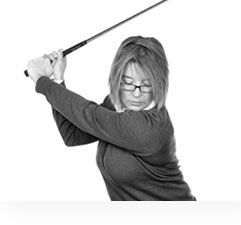 Natalie Adams – PGA Teaching Pro
Natalie Adams – PGA Teaching Pro
Here we are going to look at how to help you control the distance, that you need to hit your pitch shots. And it’s really important if you want to become accurate playing those shots into the green. The best way to work on controlling your pitching distance is to have this strategy beforehand that you have taken some time out on the range, or on the practice ground and you have just noticed how far you actually hit your shots. And what we are going to do is we are going to create a wedge chart to do that. So I would say, take a pitching wedge initially, we are going to take a ball, play it from the middle of the stance, just pull the left foot back to allow you to turn through the shot as you hit, weight slightly on the left and the hands forward. So this is a good setup position, now what we are going to do is we are going to work from that position on imagining, we have got a clock face in front of us. 12 o'clock up by our head, 6 o'clock down by the ball, we are just going to pick three times to swing to on that clock face.
So we could swing 4 o'clock, 8 o'clock, we could swing 3 o'clock, 9 o'clock or we could swing, 2 o'clock, 10 o'clock. It really doesn’t matter what you call this position, you could call those positions low, medium and high or you could call a knee height, waist height, shoulder height. But it’s the fact that you have got the three different positions on the backswing and then make sure, as you swing through, you equal and mirror that position on the follow through. So what I am going to do now is maybe take about 10 range balls and I am just going to hit some shots with the same tempo, noticing what that feels like. Is it firm, or is it soft, so here I am going to go, so let's go for a 3 o'clock, 9 o'clock position, with a nice soft tempo.
Okay and then I am going to work out, how far that ball has gone. And then I am going to take a notebook and in the notebook, once I have seen I have 10 shots I am going to take an average of that distance and I am just going to write down them on a notebook. That was my pitching wedge, I was swinging 9 o'clock to 3 o'clock, I had a smooth tempo and the distance was what the distance was. So I am going to go through that, with the 8 o'clock swing, with the 9 o'clock, the 10 o'clock swing or the low, medium and a high swing.
And I am going to do with my sand iron, my pitching wedge and my 9 iron, that will help create a chart where I have got different distances on it and then when I am out on the course, I can notice the distance I have got to play the shot, just take my yardage chart out. I have got 30 yards to play, look at where 30 yards is on my chart, and it will give me the information I need to correctly execute that shot, the distance I need to swing the club back out, which club to use and the tempo to come through the shot. That’s massively going to help you improve your accuracy.





